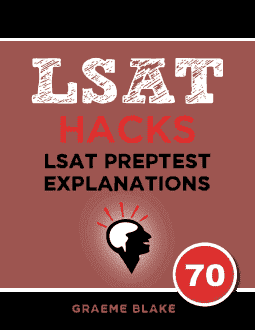QUESTION TEXT: Evidently, watching too much television can lead…
QUESTION TYPE: Weaken
CONCLUSION: TV makes people overestimate risk.
REASONING: There is a correlation between how much TV someone watches and how likely they think they are to suffer from a natural disaster.
ANALYSIS: Repeat after me: correlation does not equal causation. Correlation does not equal causation. Correlation does not equal causation.
Anytime two things happen together, that's just a correlation. In this stimulus, we have two things happening together: TV watching, and fear of natural disaster. Here are the four possibilities:
- TV causes fear
- Fear causes more TV watching
- A third factor (e.g. living in a certain area) causes both fear of disaster and TV watching.
- It's just a coincidence
You can weaken an attempt to draw causation from correlation by showing that one of the alternate possibilities is true. In this situation, it's also possible that TV watchers are the ones with a correct view of the risk of natural disaster, and therefore TV isn't misleading.
___________
- So? This doesn't show that TV doesn't cause fear.
- This heightens the tension. The people who watch the most TV have the greatest fear of natural disasters AND live in the regions with the fewest disasters.
- Tempting, but this is talking about the wrong group. If this answer had said that people who watch more TV have an accurate view, then that would weaken the idea that TV misleads.
- This shows that Television isn't responsible for educating people about natural disasters. So this answer doesn't weaken the idea that TV is a bad influence.
- CORRECT. This is number three from my list above. A third factor (risky location) leads people to watch lots of television, and to have an above average estimation of natural disaster risk.

Free Logical Reasoning lesson
Get a free sample of the Logical Reasoning Mastery Seminar. Learn tips for solving LR questions


I still don’t understand how E is the answer. Does it not strengthen the argument, especially if the problem is that TV causes fear in people.
What E shows is that the people live in a risky area. This leads them to be fearful, and also to watch TV to check the weather.
So it isn’t TV that causes fear. Actual risk in the area leads to fear, as well as TV.
Note: This is an old comment but I wanted to clarify the point.
#help
I can not eliminate A the same way. One of the ways to weaken a causal relationship is to show that when the cause doesn’t occur, the effect still does.
Answer choice A shows that (regardless of the amount of television they watch) so we can consider 0 television time, the effect (overestimate danger) still occurs.
Doesn’t this weaken the argument? Any help is much appreciated.
You’re right that when it comes to causal reasoning, if we can demonstrate that the effect is there when the cause isn’t, we’ve weakened the reasoning. However, this answer choice is vague, we don’t know exactly what percentage of this “many” are people who don’t watch an above-average amount of TV. We also don’t know what number “many” even refers to. So, at best, it weakens the argument in an extremely minor way.
(E), on the other hand, provides a very clear alternative explanation for the phenomenon in the stimulus. We’re looking for the answer choice that is the best of the five, and (E) lacks the vagueness of (A).
I would agree with your explanation regarding the “many”! The conclusion is causal… which emcompass All instances “given that the cause occurs”..
Answer choice “A” states “many” which may or may not emcompass all instances..
Answer choice “E” states “all – given the sufficient condition occurs” which emcompasses all instances..
Yes, but this is still confusing. First, the wording of the question does imply that we are supposed to assume causation — not just correlation. The word “if”, as far as I have seen in all other LSAT material, implies some form of causation. Example: “Jack will see a movie IF Jill goes to the grocery store.” This clearly implies that Jill going to the grocery store is the trigger that CAUSES Jack to see the movie. Thus, by the same logic, “People are likely to think they will be victims etc IF they watch an above-average amount of TV” should imply that the TV-watching has causal impact. Why is this incorrect?
Moreover, aren’t we supposed to take the validity of the stem at face-value? I thought our job was to criticize the support-conclusion relationship, not the objective validity of the support used. Eg, if the stem says “All psychics see the future, Jenny claims to be a psychic but she doesn’t see the future, therefore she is lying” our job is not to say “The answer is ‘psychics aren’t real’, end of story.”
I feel like this is a poorly written question and the answer doesn’t really address the flaw. The answer E seems to only address whether people are overestimating if they live in an area that happens to make them right — it doesn’t address why, for instance, the people who live in non-risky areas might still watch TV and be scared for no reason. I know there’s something I’m missing here. Help!